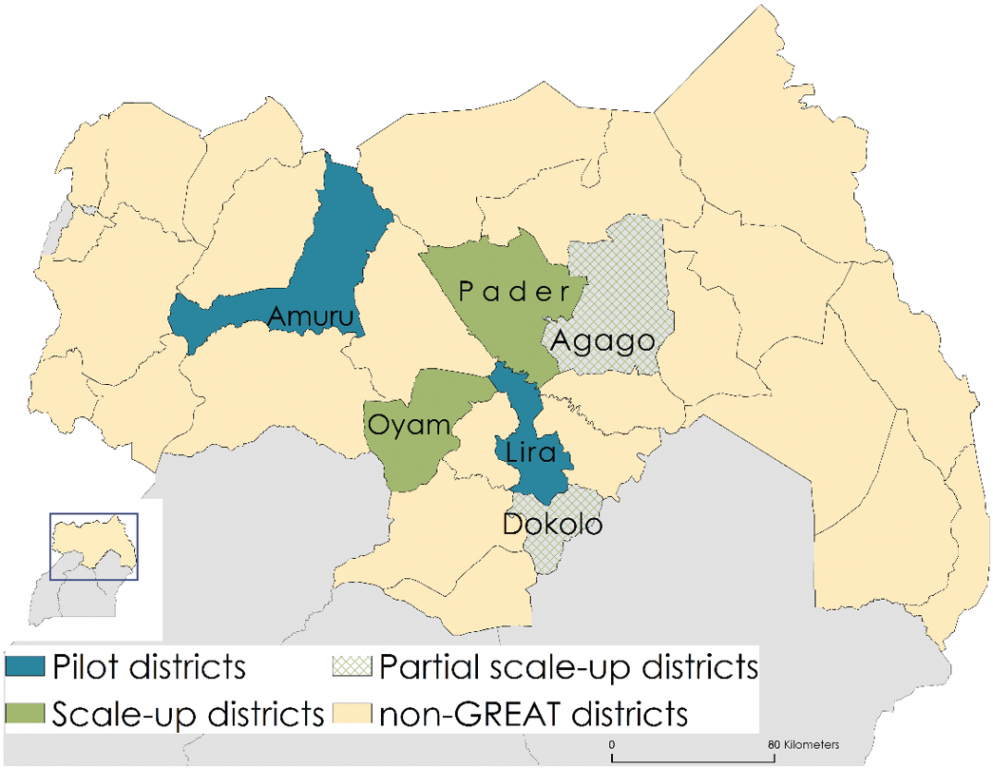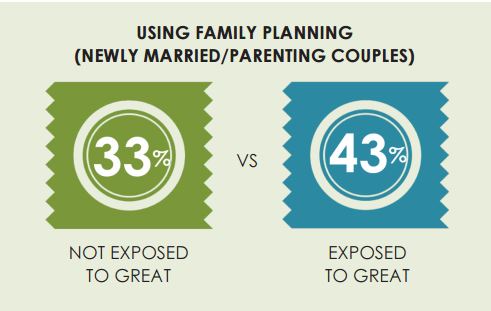In 2011, after more than 20 years of civil strife, the people of northern Uganda faced considerable sexual and reproductive health challenges stemming from the massive disruption of services, internal displacement, and erosion of traditional social and family structures.
Additionally, gender-based violence was widespread in northern Uganda. Women and girls living in conflict or post-conflict settings were particularly vulnerable to gender-based violence, a major cause of morbidity and mortality, as well as unintended pregnancy. Violence rooted in gender inequality was compounded by notions of masculinity, including the need to dominate women.
The Gender Roles, Equality and Transformation (GREAT) Project, developed by Institute of Reproductive Health at Georgetown University, Save the Children and Pathfinder International, aimed to promote gender-equitable attitudes and behaviors among adolescents (ages 10-19) and their communities with the goal of reducing gender-based violence and improving sexual and reproductive health outcomes in post-conflict communities in northern Uganda.*
GREAT is a set of participatory activities to engage adolescents and adults in discussion and reflection about how to help girls and boys grow into healthy adults who live in communities free of violence and gender inequality. GREAT activities encourage equality between women and men and include:
- Community Action Cycle: simple steps to bring communities together to take action to improve adolescent well-being
- Radio Drama: a serial drama with stories and songs about young people and their families living in Northern Uganda
- Village Health Team (VHT) Service Linkages: orientation to help VHTs offer adolescent-friendly services
- Toolkit for community groups and school-based clubs: engaging stories and lively activities and game
Social and Behavior Change Communication (SBCC) was central to the success of this project – from providing the foundations of theory and frameworks to helping develop resources and materials that would work in the field and make a difference in the lives of women and girls all over Uganda.
The Health COMpass is proud to share this project with our readership.
NEW! As of June 2016 – Take a look at the GREAT How-to-Guide
*Retrieved from: http://irh.org/projects/great_project/
**Retrieved from: http://www.pathfinder.org/our-work/projects/gender-roles-equality-and-tr…
Timeline
Inquire
During the first year of the project, IRH and partners conducted formative research, consisting of an ethnographic study and a program review to identify opportunities to promote the formation of gender equitable norms and attitudes among adolescents and the significant adults in their lives.
The ethnographic research was conducted in order to understand how gender norms are learned, internalized and passed on and why individuals would be motivated to change and to identify individuals and social institutions which play determining roles in the formation and transformation of gender roles and explore how gender roles and attitudes influence sexual and reproductive health and gender based violence.
The program review was also conducted to identify projects and programs, local and international, with successful adolescent sexual and reproductive health, gender, and gender-based violence interventions that are scalable.
Design the Strategy
GREAT was designed to:
- Shift social norms and attitudes to foster healthier, more equitable behaviors by correcting misinformation, encouraging critical reflection and dialogue, changing expectations for appropriate behavior and supporting groups to take action.
- Focus on life course transitions when adolescents learn new roles and social norms: children entering puberty, women and men entering marriage, and individuals becoming new parents.
- Diffuse new ideas and information through different levels of the community to support individual change.
- Engage girls and boys, sometimes apart, sometimes together, but always in relation to each other.
- Be scaled up by existing groups with modest additional resources.
Create and Test

The first year of the GREAT Project was dedicated to formative research to understand the trends in the learning, internalizing, and transfer of gender norms in northern Ugandan society. During the second year, IRH and partners used these findings to develop a constellation of differentiated, yet complementary interventions.
The GREAT intervention package includes the following components:
- Serial radio drama to catalyze discussion and reflection at scale
- Scalable toolkit to promote reflection and dialogue. The toolkit consists of Coming of Age Flipbooks for very young adolescent boys and girls and a Community Engagement Game and Activity Cards for all ages. The toolkit was to be rolled out through existing small groups with guidance and support by community groups and field workers from GREAT partners
- Community Action Cycle (CAC) conducted with community leaders to strengthen their capacity to promote and sustain change
- Training and engaging Village Health Teams to improve access to and quality of youth-friendly SRH services
- Cross-cutting activities to recognize and celebrate people who demonstrate commitment to gender-equitable behaviors
Starting in 2013, the GREAT implementing partners began distributing the toolkit to school and community groups in Lira and Amuru districts. The distribution included orienting group leaders and members on the use of the toolkit components. The scalability of GREAT rests in its strategy of diffusing information through existing groups with minimal orientation. These groups were the catalysts for spreading GREAT themes within their communities. Additionally, the project set up monitoring systems which involved community members in in collecting, analyzing, and using data to improve the interventions.
Over the course of the project, all intervention components were piloted and evaluated for impact. Successful components were scaled up to additional districts in the final year of the project. Momentum started building around the toolkit, with stakeholders in and outside of Uganda interested in integrating tools such as the board game, radio drama, and adolescent flipbooks into their programs.
The large map below shows the pilot and scale-up areas of the project.
Here are more detailed maps of each of the districts: Amuru, Pader, Lira, Oyam

- GREAT Project How-to-Guide
- GREAT Scalable Toolkit
- GREAT Flipbook for Girls
- GREAT Flipbook for Boys
- GREAT Game
- GREAT Radio Discussion Guide
- GREAT Activity Cards: Married/Parenting Adolescents
- GREAT Activity Cards: Older Adolescents
- GREAT Activity Cards: Very Young Adolescents
- GREAT Community Action Cycle Implementation Guide
- GREAT How-to Guide
Mobilize and Monitor
The second phase (2011-2013) of the GREAT project focused on designing and piloting interventions.
These interventions included:
- A toolkit of scalable products to be used by young people in platforms to dialogue and reflect on their own gender norms and sexual reproductive health
- A serial radio drama called Oteka that was broadcast on two local radio stations in northern Uganda
- A strategy for improving access to sexual reproductive health services by adolescents that focuses on working with the Village Health System and health care providers to improve their skills and attitudes towards adolescents health
- A GREAT champion’s recognition strategy
During the pilot phase, the project also rolled out a community mobilization approach known as the community action cycle and formed Community Mobilization Teams and Community Action Groups in the pilot districts of Lira and Amuru.
Evaluate and Evolve
Once the intervention package was developed, the team conducted a baseline survey in schools and households in order to measure key knowledge, attitudes, and behaviors before the start of intervention activities. The baseline survey was to serve as a source of comparison data to data collected after the end of project activities. In addition, initial interviews were conducted with a cohort of 60 young people who will be interviewed every six months over the life of the project. The results were aimed to increase understanding of how gender norms evolve over time and provide information on the ways that youth are engaging with components of the GREAT interventions.
End of Intervention Survey Methodology
To understand how adolescents participated in GREAT and what difference it made in their lives, the team conducted:
- Focus group discussions and in-depth interviews with 152 adolescents participating in GREAT
- Four rounds of in-depth interviews with 30 males and 30 females in control and intervention areas over a two year period
- A survey of 4,500 adolescents and adults in Amuru and Lira districts before GREAT began and again after almost two years of implementation
Data was collected from communities where GREAT activities took place (intervention), as well as similar areas where no activities were planned (control).
General results
- GREAT led to significant improvements in attitudes and behaviors among exposed individuals, as compared to a matched control group created by propensity score analysis
- Participation of one group each of VYAs, older adolescents and newly married or parenting adolescents in each community was insfficient to spark community-wide change
- The serial radio drama was an effective strategy to reach community members who did not participate in small group activities.
- Determining the effect of community mobilization activities remains a challenge.
- Although GREAT was successful in achieving individual change, expansion must focus on increasing depth and breadth of coverage to reach a “tipping point” of community change.

Results by theme:
| Family planning attitudes, communication, and use |
| Most young people who participated in GREAT showed improved attitudes and behaviors related to sexual and reproductive health. |
| Gender equitable attitudes and behaviors |
| Exposure to GREAT resulted in more gender-equitable attitudes, and some changes in behaviors. For example, fewer older adolescents exposed to GREAT held inequitable gender norms. |
| Attitudes towards intimate partner violence, conflict management and sexual harrassment |
| Changing acceptance of men’s use of violence to control their wives takes time, however improved attitudes and less violence were seen among adolescents involved with GREAT. There was a significant decrease in newly married/parenting women and men who report reacting violently to their partner when they are angry. |
| Adults advise adolescents on gender equality, SRH and GBV |
| In order to improve equitable attitudes and behaviors among adolescents, adult support is needed. GREAT contributes to an environment that supports adolescent development. |
Results Graphs:




Planning for the Future
The team learned that helping adolescents manage key life transitions and encouraging discussion of different expectations of what it means to be a man or a woman makes a positive difference in their lives. District officials and community organizations are now working to include GREAT in their budgets, work plans and monitoring activities in order to maintain the momentum.
GREAT will act on pilot findings to scale up in a way that moves beyond individual to community-wide change, and contributes to broader learning.
GREAT Collaboration Team
- Pathfinder International (Callie Simon, Gwyn Hainsworth, Susan Oregede, Tara Acton, Geoffrey Opyet, Emilly Katamujuna, Dennis Kibwola)
- Save the Children (Brad Kerner, Benon Orach, Dickens Ojamuge, Pauline Kabagenyi)
- Concerned Parents Association (Pamela Lubik, Nelson Omara, Nicholas Owor, Joseph Kasonogo)
- Straight Talk Foundation (Christine Lamunu, Yusuf Odongpiny)
- NaNa Development Consultants Limited (Sam Birago, Dennis Nabembezi, Symon Wandiembe)
- Applied Research Bureau (Paul Bukuluki)
- Institute for Reproductive Health, Georgetown University (Rebecka Lundgren, Victoria Steven, Danielle McCadden, Valerie Mahar, Melissa Adams, Sophie Savage, Fred Mubiru, Thomas Odong, Gratian Masendi, Sam Okello, Sarah Burgess, Nana Apenem Dagadu)
Photo Credit: Sophie Savage/Institute for Reproductive Health, Georgetown University
Date of Publication: April 20, 2022



